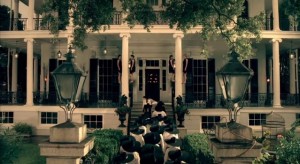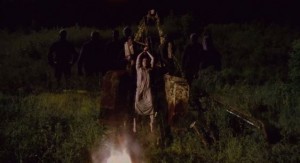High Hopes, but Coven Falls Short

I had high hopes for the third season of American Horror Story, titled Coven. First off, the feminist themes underscoring the second season, Asylum, kept me watching the show even though the first season had me cringing at unnecessary misogyny. Asylum had overtly feminist moments that were almost so feminist that they ended up cliche.
American Horror Story has worked to perfect a weird balance of misogyny with feminism and, more importantly, feminist cultural criticism.
As explained by Alison Herman, though:
“Writing female characters into situations where they’re brutalized isn’t sexist in and of itself; it’s often an opportunity to comment on the systems that brutalize them. The problem with American Horror Story‘s previous attempts to translate terror into a takedown of the ‘patriarchal male,’ an epithet Jessica Lange spits out early in Asylum as hard-bitten Massachusetts nun Sister Jude, has been its inability to use that opportunity to do much more than say ‘men bad, female protagonist good.’”
I would also argue, however, that seasons two and three of American Horror Story have failed to take the situations in which women are brutalized and use them as a framework for cultural criticism. Instead of the characters and the subsequent stereotypes attached to them (many of which they supposedly break out of by the end of the season – or the characters just die) serving as criticism of larger systems which created the aforementioned stereotypes, most of these character attributes lack the push from controversial/offensive stereotype to teaching tool. I often found myself thinking that, to the untrained eye, any cultural criticism could go virtually unnoticed. This is where my love/hate relationship of the most basic aspect of American Horror Story, the utilization of the coven/witches at all, comes in.

While watching Coven, I found myself grappling with how I felt about the theme of the entire season. On the one hand, it’s a great idea: a coven of witches who, inherently, exist outside of patriarchal control. It seems like the ideal premise for a show which seeks to openly criticize patriarchy. However, it’s upsetting that they almost had to use the coven as a means to talk about these issues.
I was left wondering, would the average audience have “put up” with the blatant feminism, race relations, etc. if the theme wasn’t Coven?
As Andi Zeisler of Bitch pointed out:
“Witchcraft, after all, has historically been associated with women whose talents, personalities, and life choices didn’t jibe with those of the status quo, and the horrible things that were done in the name of purging communities of witches were at heart an expression of fear—fear of women who don’t conform, fear of women who have no use for the usual institutions of male power, fear of women who can make shit happen.”
This backstory makes the utilization of the witch coven as a means to talk about feminist issues both, as Herman stated, “an opportunity to comment on the systems that brutalize [women]” and a way to simultaneously feed into the many stereotypes of women and witches (or women as witches, but you get the point.)
At the same time, American Horror Story fails to accurately address the issues which they are apparently integrating throughout the season. Coven showcases scenes in which there is a sort of pseudo-empowerment acquired by various witches.
However, in the case of Queenie, for instance, they feed into racial stereotype after racial stereotype.
Blogger Charing Ball explains that, rather than let Queenie’s character be a fully actualized and more accurate representation of black women:
“The writers and creators of the series felt it necessary to make [Queenie] into a caricature of what we always tend to associate with being a heavy-set, dark-skinned woman. I’m not talking about the fact that she is often seen as angry and yes, even sassy… I’m talking about the fact that her name is ‘Queenie’ and she is from Detroit. And she used to work in a fried chicken shack. And that unlike her other white witch counterparts, her witchery is rooted in voodoo (which in the show is portrayed as ‘dark magic’ as opposed to birthright witchcraft like the rest of the Coven). And her magic power is being a.. human pin cushion doll. That’s right, week after week of the series we got to watch Queenie graphically mutilate herself as a way to defend those, who sought to do her personal harm.”
I was fairly impressed with the fact that it wasn’t a part of Jamie Brewer’s character, Nan, at all that Brewer has Down syndrome (as it was in the first season), but I wish they would’ve extended that same way of thinking to Gabourey Sidibe’s character, Queenie. Throughout the season, Queenie refers to her size several times, and while I don’t think that her size should necessarily be ignored, it shouldn’t need to be a part of the plotline either. The fact that Brewer’s Down syndrome was not a part of her character was rather radical, in my opinion. However, I found that the writers use of stereotypes toward Queenie on the basis of race and size to be objectionable.
There are ways to touch on size or race so that it is not derogatory or offensive, and often those ways make it so that it’s informative and educational as well.
Rather than use the several statuses Queenie occupies to spark constructive discussion about the racism or sizeism, however, the writers simply made tasteless side jokes that never really reached actualization in the form of a productive discussion.

In a YouTube video released by FX, they provide an explanation of Queenie’s character which paints it as seemingly admirable; however, I have yet to be sold on the continuous use of stereotypes as entirely racist cultural criticism and still think the show is feeding into these stereotypes as well. Queenie doesn’t really ever reach the point where she breaks the mold by the end of the show (not many of them do, to be honest, but considering the extremely problematic nature of Queenie’s character, this is noteworthy.)
With that in mind, the supposedly underlying theme of race relations never really amounts to anything at all.
It’s almost as if the writers and creators of the show made the decision to incorporate issues of race, gender and arguably class (as expressed in the video linked above) and then gave up on the whole idea in the screenwriting process.
If anything, I found throughout the season that the writers made it so that your sympathies lie with Delphine LaLaurie (the “immortal racist” referred to and depicted in the aforementioned video), even after the audience is educated on the brutality of the crimes she’s committed. And although she meets her demise in the form of her own personal hell where she is in the position of the slave, I don’t think that redeems the countless episodes the writers spent making the audience question their initial feelings about Delphine. From the beginning of the show, the audience is made to see Delphine as a racist murderer, yet as the show pans out, the writers begin to give her humanity, painting her in a sympathetic light. Again, the writers completely half-assed that aspect of the show. However, this issue has already been articulated by cultural critic after cultural critic, including Shawn Binder for Thought Catalog in saying that:
“Not only did [the writers] treat the subject matter as a superfluous subplot, they dropped it almost immediately as they were getting somewhere. Was there a point in the budding friendship between Delphine and Queenie? As soon as they got close, they both wound up screwing each other in favor of personal gain… They showed Queenie’s hell as being forced to work in a fried chicken shack and Marie Laveau’s distaste for white people rooted the only conversation about race in gross stereotypes that actually worked against any point the show was attempting to make.”
I had hoped for more from Coven, but it seems as if they missed the mark on multiple platforms. I can only hope that the writers learn from the pitfalls of this season for the next season.




